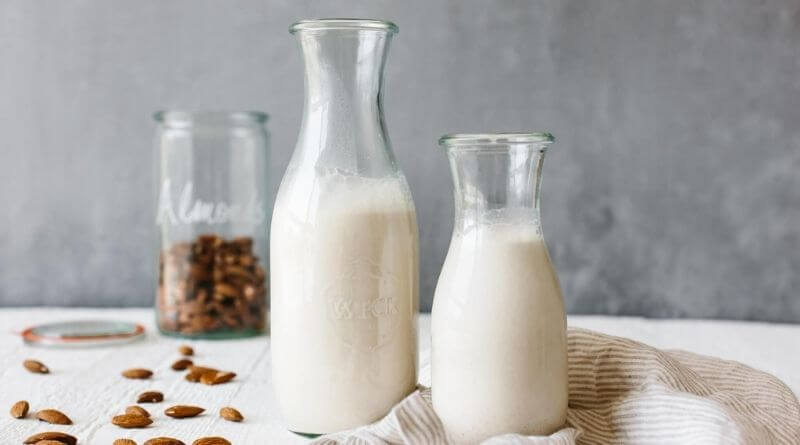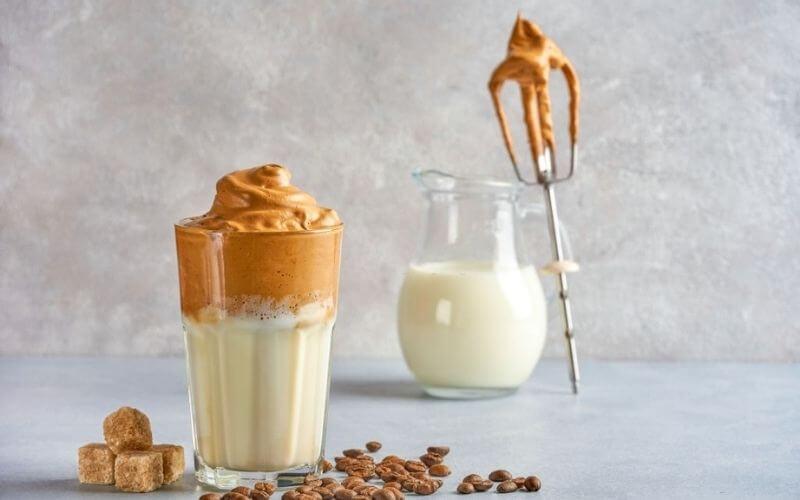Whether you’re vegan or lactose intolerant, the restriction of full-fat dairy milk can stand in the way of the perfect cup of coffee. While regular milk steams beautifully, easily transforming to the frothy silkiness that melts into espresso like a dream, plant-based milk is a whole different story.
Vegan alternatives, like almond milk, are much harder to froth. Sometimes the milk will be too watery and refuse to foam at all.
At other times, the milk will froth up weakly, with just a few bubbles and not the luxurious micro-foam that we know and love.
Can you froth almond milk? Yes, but you need to know how to do it right.
If you are tired of drinking subpar cappuccinos or bland lattes, you’ve come to the right place. This article will show you how to froth almond milk perfectly, creating the perfectly textured milk and foam to top off your coffee drinks.
You will learn how to identify the best almond milk for frothing, as well as the factors that determine the quality of your frothed almond milk. If you want to make a perfect latte with almond milk, keep reading to learn more!
Can you use almond milk in a frother?

You can use almond milk in a frother to make the perfect cup of coffee. Almond milk has been known for its ability create beautiful, rich foam that is often used by baristas who want their customers’ drinks tastes just how they like them without having any animal products added into it!
The Benefits of Almond Milk
Almond milk is a healthy and nutritious alternative to cow’s milk. It has a low calorie and fat content, making it a good choice for weight loss. It also contains a lot of calcium, vitamin D, and other elements that are good for your bones.
It is also high in antioxidants, which can help prevent cell damage and lower the risk of chronic disease.
Frothing Almond Milk
Frothing almond milk is the technique of adding air into the milk to create a creamy texture. This can be accomplished using a variety of instruments, such as a frother, blender, or whisk.
It is simple and simple to foam almond milk at home. It’s a terrific method to give your coffee or tea a thick, velvety feel.
Best Ways to Enjoy Frothed Almond Milk
Coffee: Adding frothed almond milk to coffee creates a thick and creamy texture. It can be used to prepare a variety of coffee beverages, including lattes, cappuccinos, and macchiatos.
Hot Chocolate: Delicious hot chocolate can be made with frothed almond milk. It imparts a creamy and velvety texture to the drink, enhancing its flavour.
Smoothies: Smoothies can be made with frothed almond milk. It gives the smoothie a creamy texture, making it more delicious and filling.
How to Steam Almond Milk
In the beginning, alternative, plant-based milk may seem complicated to try and steam in comparison to regular cow’s milk. We’re here to tell you that’s not the case! Here are three ways to steam almond milk at home:
With A Steamer
The most straightforward way to steam almond milk is to use the steamer attached to your espresso machine. Simply pour the milk into a jug and use the attached steaming wand, making sure you get a good froth from the bottom until the surface of the milk.
However, if a steamer isn’t an option for you, we completely understand! There are other alternatives we will jump into.
With a Microwave
For steaming milk in a microwave, you should use a microwave-safe jar. Pour the milk into the jar and give it a good, hard shake. Shake for at least 30 seconds to get everything frothy and bubbly. Now, put it in the microwave on low heat to warm it up. The foam will stay and you have the frothy milk you need for a nice latte!
With A Saucepan
Another easy way to steam almond milk is by using a saucepan. Set your stovetop to a low heat before adding the saucepan with milk in it. Leave it on low heat for a few minutes as you use a hand frother to get the bubbly texture!
The Science of Frothing Milk

While we rarely stop and think of the mechanics of frothing milk, there is a science that determines how well the milk in question will froth. Certain factors decide whether your milk will froth properly and hold its shape or not at all.
To put it simply, the following will determine the way your almond milk will froth:
Protein and Fat Content:
Any kind of milk, dairy, or plant-based, has 3 main components: proteins, fats, and carbohydrates. The amount of fat and protein (and their ratio) is what determines the frothiness of your steamed milk.
Milk containing more fat and protein will froth much more easily than low-fat milk types. Because of this, you should try to buy coffee almond milk with higher fat content.
Milk Quality:
The quality of milk is crucial when using non-dairy variants. Use the freshest almond milk you can find, as milk close to expiring will barely froth at all. Also, some cheaper brands of almond milk use very little almonds, making the milk ultra-thin and watery that won’t even froth.
Even the kind of almonds used is important. Use a brand that uses quality almonds that yield almond milk with a good amount of fat, protein, and sugar. A smooth and rich almond milk will give you the best kind of froth for your coffee.
If you make your own almond milk at home, use good almonds and don’t water it down too much.
Temperature:
Dairy milk is notorious for being finicky; it splits or curdles at high temperatures and goes brown quickly-stuff you wouldn’t want in your cappuccino. Vegan milk also needs to be monitored when heating, as it can curdle as well.
When it comes to almond milk, you need to be extra careful. Almond milk scorches and burns very quickly, so warming in a pan is risky as the milk can boil and burn.
Can you boil almond milk in a microwave? It’s unlikely, so this is the safest route.
The wrong temperature can mess with the froth and cause your milk to lose its texture.
According to a study by the Journal of Food Science and Technology, heating your almond milk to around 65°C (or 150-155°F) is the sweet spot for achieving a great froth.
Can you microwave almond milk without it splitting? Yes, but you have to keep an eye on it.
How to Froth Almond Milk

This section will look at how to make froth milk using almond milk. Whether you have an espresso machine with a steaming wand or just an old microwave, or single frother unit, you will be able to make steamed almond milk that is textured and velvety.
Using A Steaming Wand:
This may be the most common way to steam milk and is used by baristas and coffee shop workers. Steaming wands come with espresso machines and work by infusing the milk with steam, creating bubbles and texture that give rise to lots of foam.
Here’s how this works:
- Add cold almond milk to the steaming pitcher or any steel pitcher.
- Hold the pitcher at an angle and place it under the steaming wand.
- Insert the steaming wand into the milk, holding just below the surface of the almond milk. Use the steam output dial to give off a steady stream of steam.
- Hold the tip of the wand to the side of the pitcher, making a sort of vortex in the milk.
- Move the pitcher around the wand, then up and down, as this incorporates more air into the almond milk which splits larger bubbles.
- Over time, the bubbles will get smaller and the milk will double in size. Once this happens, your milk is done steaming. Turn off the dial and remove the pitcher from under the wand.
Your almond milk is done steaming and is ready to use! The thick and frothy milk will smoothly mix with the espresso and has lots of foam that you can use to make latte art.
Using a Handheld Frother:
Battery-operated handheld frothers are the easiest and most accessible way to make steamed milk if you don’t have a home café with an espresso machine and steaming wand attachment. They are cheap, easy to use, and froths milk quickly.
- Pour your almond milk in a large jar, mug, or pitcher.
- Insert the tip of the frother into the milk, just below the surface.
- Turn on the frother and froth the milk for 30 seconds.
- Then, move the wand up and down and froth for another 30 seconds.
- Finally, swirl the wand around the pitcher and continue frothing until the milk is silky and increases in volume.
- Microwave the milk for 30 seconds, as this heats up the milk and stabilizes the foam, giving you a little more time to worth with the textured milk.
Using a Jar:
If you are desperate for a good latte but don’t own a conventional frother, this method is for you. Here is how to froth milk without frother-all All you need is a sturdy jar!
- Fill half or a third of a jar with your almond and make sure the lid is screwed on tightly.
- Then shake the jar vigorously. This will take a bit of time so don’t lose patience. Keep shaking the jar until the milk almost doubles in size. The process takes around 5 minutes, so consider it an arm workout!
- Then, remove the lid and microwave the milk for 30 seconds. This will stabilize the foamed milk and give it a smooth and even texture.
- Pour the frothy milk into your coffee, or spoon the foam over your drink.
Tips for Perfectly Frothy Almond Milk
Heating almond milk is tricky, and frothing it is even harder, especially if you are new to the art of whipping up coffee beverages. Combining the two can be intimidating, but these tips will make the whole thing seem much easier!
Use Fresh Milk:
As mentioned earlier, your almond milk needs to be as fresh as possible. Make sure your milk has 5-6 days before it expires, as milk at this stage will yield the most foam and smooth, textured milk. Freshly made almond milk can hold its shape when steamed and is less likely to curdle when heated.
Keep Things Chilly:
When frothing almond milk, make sure the milk is very cold and taken right out of the fridge. Almond milk froths better when cold. Can you warm almond milk before frothing? Yes, but it won’t foam up as well as cold milk.
Use a Smaller Container:
The pitcher you steam or froth your milk should be rather small, just large enough to hold the volume of the milk when it doubles. This will give your frothed milk a nice and even texture, with microbubbles instead of larger ones.
Frequently Asked Questions
Here you will find answers to questions or issues that arise when frothing almond milk.
01. Can I Heat Almond Milk?
Heating almond milk is doable, but the milk overheats and burns very quickly. As a result, you have to be careful and heat it in a microwave or double boiler.
02. Is It Possible to Froth Flavored Almond Milk?
As long as the almond milk has the right levels of fat and protein, it will froth just fine. However, if you don’t want to risk messing the milk up, add flavored syrups and sauces after assembling your coffee.
03. Which Non-Dairy Milk is the Best for Frothing?
When it comes to frothing plant-based milk, coconut milk and oat milk is the best option.
04. Which Almond Milk Froths the Best?
Almond milk that has more protein will froth better. It is also important to make sure that the milk has lots of fat as well.
05. Why Does My Almond Milk Curdle When I Add It to My Coffee?
Almond milk curdles very easily. The extreme temperature between freshly brewed hot coffee and frothy almond can cause it to curdle. However, while unappealing, the coffee will still be safe to drink and won’t affect the flavor.
In a Nutshell
Almond milk is one of the most popular plant-based milk out there. Adding it to coffee beverages will give your drink a nutty undertone that adds lots of flavors. Frothing almond milk the right way will help you make a coffee that tastes like stuff made by baristas at a fraction of the price.
Once you know how to froth almond, you can tweak lots of latte and cappuccino recipes to your own liking. Or you can continue using a range of great non-dairy creamers in your coffee. The choice is yours, as long as you make vegan coffee that makes your heart sing!




